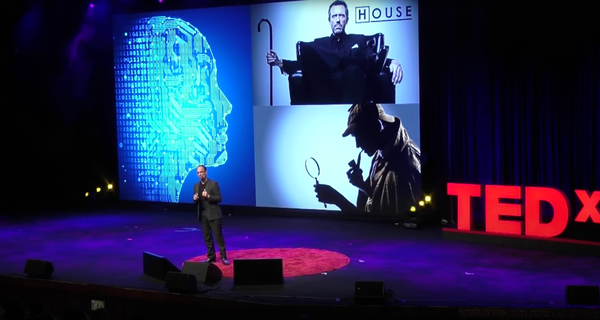I̶̶ ̶R̶o̶c̶k̶!̶ ̶Doc Rocks! :)
Notes on Doc Searl's ca. 2004 ruminations on how the software industry might develop.

Doc Searls is just wrapping up his "Open Source and the Changing Face of IT" session at the Sun Open Source Summit. Quite honestly, I have never sat in a session that was as engaging, funny or useful. (Yes Kathy, I have to agree with your description of the excellent user experience as being one where the user feels empowered (or as you put it, they should have the feeling of, "I Rock!") I definitely feel that I rock right now. :)
For those of you who don't feel like reading a set of bullet points without much context behind them, here are a few of the funny bits:
- Doc speaking about he and his wife having thirty-year old children and a seven-year-old child: "We thought that aging was birth control."
- Describing a certain period in time, "When the IBM guys still looked like the FBI."
- "Nobody every went into their business for their shareholders."
- Commenting on a photo of a skyscraper, "This is a photo of the Pfizer building. Also known as the Viagra building. It went up very fast."
Some of the most interesting snippets from the talk were
- A brief summary of George Lakoff's work on cataloguing the different pathos, ethos and vocabularies of conservative and liberal politics.
- A discussion of how the compelling language of marketing, sales, politics, conservatism and so on is the extremely compelling language of war: attack, campaign, defend, flank, impact, marshall, bomb, etc. (Described as the word box of War)
- It is compelling because a dangerous world is more interesting than a nice one.
- A quote from Patton: "Compared to war, all other forms of human endeavor shrink to insignificance. God help me I love it so."
- No box of words is handier than the war box.
- Microsoft is not a competitive company, it is a combative company. Each threat is perceived as mortal.
- As a Netscape exec once said about Microsoft: "They want to kill us. This has a polarizing effect."
- Conflict generates interest.
- One example provided is how SPARC picked a fight with MIPS to build a compelling story at a time when the market was only interested in Intel and Motorola. Small spiteful things like spelling SPIM backwards as a way to make fun of the byte order of MIPS processors. (Of course spelling SPARC backwards is an effective counterattack.)
- The conflict made the story interesting.
- The point of all this is everything interesting has a story
- A few key points from a book called, "Writing to Sell" - good stories have:
- Identification (with a character)
- Problem (a struggle)
- (moving towards a) Resolution
- The Linus/Linux story
- He came from Finland
- The penguin
- World domination
- There are two kinds of stories about open source:
- outside
- inside
- Outside - mostly about what vendors do for customers
- Inside - what customers do for themselves - how customers are enabled with open source - mostly about saving money and getting stuff done
- Outside stories are often not compelling
- Inside stories are often hidden by legal needs
- The construction industry has provided a vocabulary for software development and may provide a good future model of the industry as well.
- The borrowed bits of the construction vocabulary include: architect, build, design, tool, site, under construction, assemble, construct(or), ...
- Construction is interesting in many ways:
- It is the oldest and largest industry
- The use value of a building subordinates sale value
- Sharing know how is natural and required
- Commodities are ok
- Margins under 80% are ok
- There may be other interesting models lurking within construction. Doc cites a book by Steward Brand titled, "How Buildings Learn"
- Roughly stated, Brand asserts that there are two kinds of architecture:
- magazine (idealized architecture - no one lives in it)
- vernacular (very local - differs where you are - uses local materials, styles, etc)
- Construction can also be split two ways:
- high road (very expensive, built to last, idealized in a different way - cathedral, castle, etc - mindfulness of the long term)
- low road (temporary structures, cheap, ugly, meant to change)
- A classic example of low road construction is the late building 20 at MIT, which served as a site for a lot of interesting work, including some of George Lakoff's.
- Open Source is like vernacular, low-road architecture. It tends to be native, casual, astute, more craft than art, smart, self-educated and designed to rapidly change
- Roughly stated, Brand asserts that there are two kinds of architecture:
- Doc asserts that the software industry is maturing into the construction industry
- mostly belongs to architects, designers and builders
- mostly about who does the work and how
- mostly a series of projects - rob glaser
- mostly diy
- while there are huge companies in the construction industry, there is no behemoth like Microsoft
- Construction's virtue is not openness, it is modularity
- it is full of modularity
- parts are substitutable
- IP issues are isolated. Some parts may be patented, but they are modules that are isolates from other modules
- components and professionals value independence
- Doc then goes on to discuss how his friend Craig Burton analyzed some of the open source dynamic. He drew a diagram something like this:
open
|
proprietary -+- public domain
|
closed
However, people tend to view the model more like this
open / good vs. closed/bad
or like this:
open good
|/
proprietary -+- public domain
/|
bad |
closed
The model is more like this:
open ubiquity
| /
proprietary -+- public domain
/|
bad |
closed




